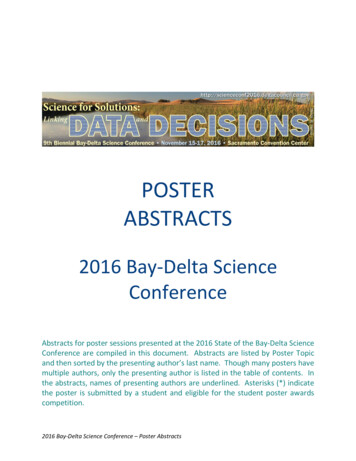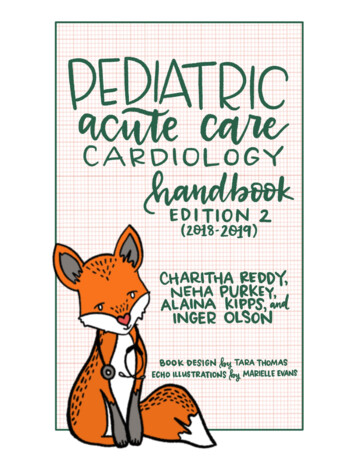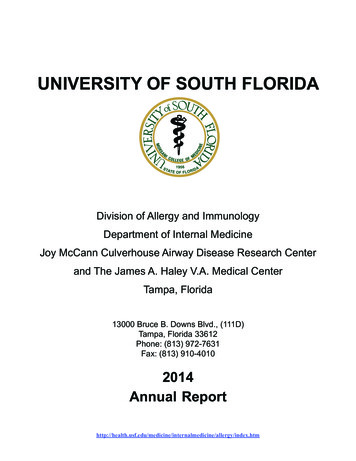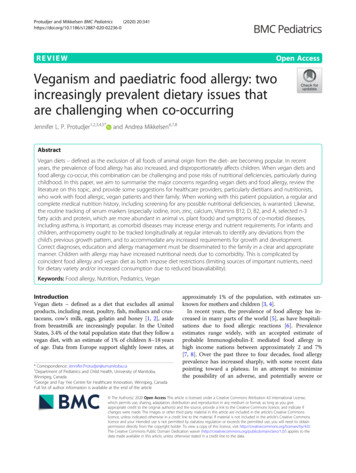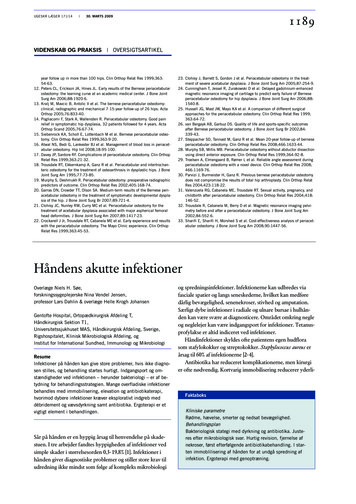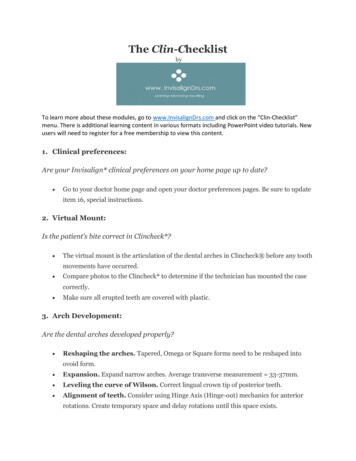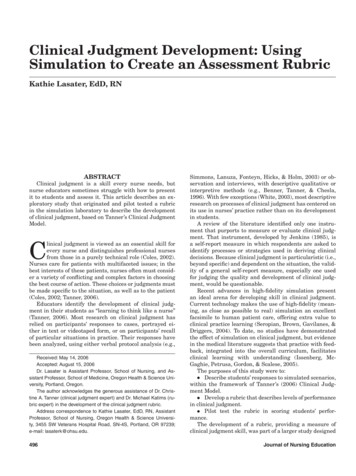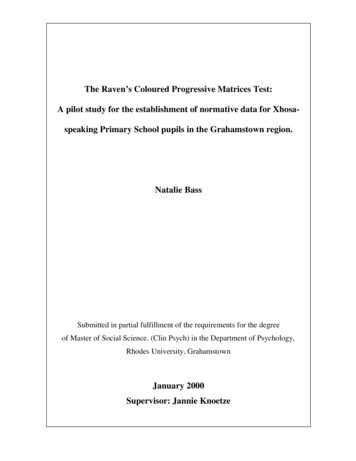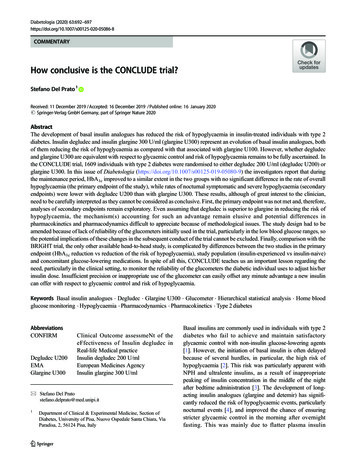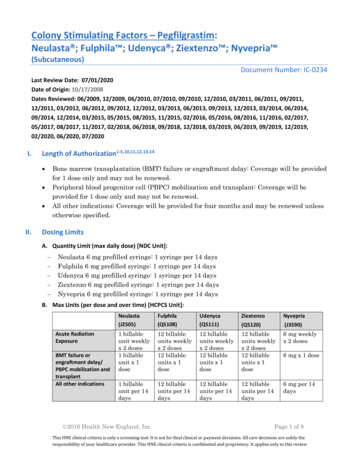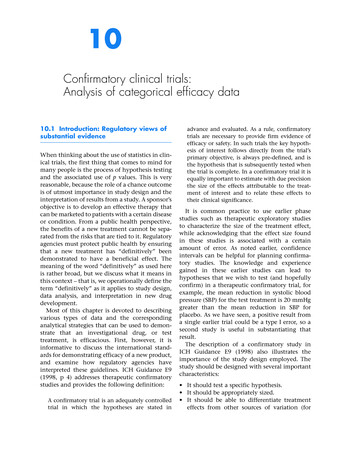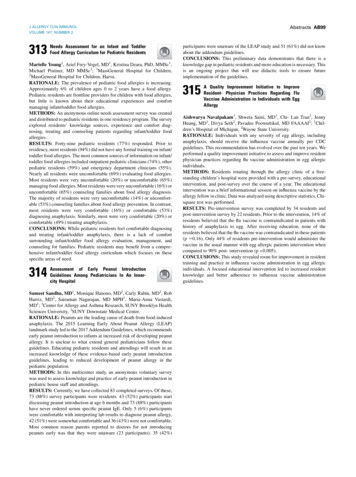
Transcription
Abstracts AB99J ALLERGY CLIN IMMUNOLVOLUME 147, NUMBER 2313Needs Assessment for an Infant and ToddlerFood Allergy Curriculum for Pediatric ResidentsMarielle Young1, Ariel Frey-Vogel, MD1, Kristina Dzara, PhD, MMSc1,Michael Pistiner, MD MMSc2; 1MassGeneral Hospital for Children,2MassGeneral Hospital for Children, Harva.RATIONALE: The prevalence of pediatric food allergies is increasing.Approximately 6% of children ages 0 to 2 years have a food allergy.Pediatric residents are frontline providers for children with food allergies,but little is known about their educational experiences and comfortmanaging infant/toddler food allergies.METHODS: An anonymous online needs assessment survey was createdand distributed to pediatric residents in one residency program. The surveyexplored residents’ knowledge sources, experience and comfort diagnosing, treating and counseling patients regarding infant/toddler foodallergies.RESULTS: Forty-nine pediatric residents (77%) responded. Prior toresidency, most residents (94%) did not have any formal training on infant/toddler food allergies. The most common sources of information on infant/toddler food allergies included outpatient pediatric clinicians (74%), otherpediatric residents (59%) and emergency department clinicians (55%).Nearly all residents were uncomfortable (69%) evaluating food allergies.Most residents were very uncomfortable (20%) or uncomfortable (65%)managing food allergies. Most residents were very uncomfortable (16%) oruncomfortable (65%) counseling families about food allergy diagnosis.The majority of residents were very uncomfortable (14%) or uncomfortable (53%) counseling families about food allergy prevention. In contrast,most residents were very comfortable (16%) or comfortable (53%)diagnosing anaphylaxis. Similarly, most were very comfortable (20%) orcomfortable (49%) treating anaphylaxis.CONCLUSIONS: While pediatric residents feel comfortable diagnosingand treating infant/toddler anaphylaxis, there is a lack of comfortsurrounding infant/toddler food allergy evaluation, management, andcounseling for families. Pediatric residents may benefit from a comprehensive infant/toddler food allergy curriculum which focuses on thesespecific areas of need.314Assessment of Early Peanut IntroductionGuidelines Among Pediatricians In An Innercity HospitalSumeet Sandhu, MD1, Monique Hanono, MD2, Carly Rabin, MD2, RobHarriz, MD2, Sairaman Nagarajan, MD MPH1, Maria-Anna Vastardi,MD1; 1Center for Allergy and Asthma Research, SUNY Brooklyn HealthSciences University, 2SUNY Downstate Medical Center.RATIONALE: Peanuts are the leading cause of death from food-inducedanaphylaxis. The 2015 Learning Early About Peanut Allergy (LEAP)landmark study led to the 2017 Addendum Guidelines, which recommendsearly peanut introduction to infants at increased risk of developing peanutallergy. It is unclear to what extend general pediatricians follow theseguidelines. Educating pediatric residents and attendings will result in anincreased knowledge of these evidence-based early peanut introductionguidelines, leading to reduced development of peanut allergy in thepediatric population.METHODS: In this multicenter study, an anonymous voluntary surveywas used to assess knowledge and practice of early peanut introduction inpediatric house staff and attendings.RESULTS: Currently, we have collected 83 completed surveys. Of these,73 (88%) survey participants were residents. 43 (52%) participants startdiscussing peanut introduction at age 6 months and 73 (88%) participantshave never ordered serum specific peanut IgE. Only 5 (6%) participantswere comfortable with interpreting lab results to diagnose peanut allergy,42 (51%) were somewhat comfortable and 36 (43%) were not comfortable.Most common reason parents reported to doctors for not introducingpeanuts early was that they were unaware (23 participants). 35 (42%)participants were unaware of the LEAP study and 51 (61%) did not knowabout the addendum guidelines.CONCLUSIONS: This preliminary data demonstrates that there is aknowledge gap in pediatric residents and more education is necessary. Thisis an ongoing project that will use didactic tools to ensure futureimplementation of the guidelines.315A Quality Improvement Initiative to ImproveResident- Physician Practices Regarding FluVaccine Administration in Individuals with EggAllergyAishwarya Navalpakam1, Shweta Saini, MD1, Chi- Lan Tran2, JennyHuang, MD1, Divya Seth2, Pavadee Poowuttikul, MD FAAAAI2; 1Children’s Hospital of Michigan, 2Wayne State University.RATIONALE: Individuals with any severity of egg allergy, includinganaphylaxis, should receive the influenza vaccine annually per CDCguidelines. This recommendation has evolved over the past ten years. Weperformed a quality improvement initiative to assess and improve residentphysician practices regarding flu vaccine administration in egg allergicindividuals.METHODS: Residents rotating through the allergy clinic of a freestanding children’s hospital were provided with a pre-survey, educationalintervention, and post-survey over the course of a year. The educationalintervention was a brief informational session on influenza vaccine by theallergy fellow in clinic. Data was analyzed using descriptive statistics. Chisquare test was performed.RESULTS: Pre-intervention survey was completed by 34 residents andpost-intervention survey by 22 residents. Prior to the intervention, 14% ofresidents believed that the flu vaccine is contraindicated in patients withhistory of anaphylaxis to egg. After receiving education, none of theresidents believed that the flu vaccine was contraindicated in these patients(p 50.16). Only 44% of residents pre-intervention would administer thevaccine in the usual manner with egg allergic patients intervention whencompared to 90% post- intervention (p 0.005).CONCLUSIONS: This study revealed room for improvement in residenttraining and practice in influenza vaccine administration in egg allergicindividuals. A focused educational intervention led to increased residentknowledge and better adherence to influenza vaccine administrationguidelines.
AB100 Abstracts316Dietary Normalization Following A SuccessfulOral Food Challenge In Children With FoodAllergiesElizaveta Rakhmanova, BSc1, Kuang-Chih Hsiao, MBChB2; 1University of Auckland School of Medicine, Auckland, New Zealand, 2StarshipHospital, Auckland District Health Board, Auckland, New Zealand.RATIONALE: Oral food challenge (OFC) is a resource-intensive yetinvaluable investigation for diagnosing food allergy (FA) and confirmingFA resolution. Some recent case series report low rates of regular dietaryconsumption of previously implicated allergen despite successful OFC,with no local data available to date. We hypothesized that continuedingestion rates post successful OFC may be influenced by patient andprocedure-related factorsMETHODS: We identified 195 children who passed an OFC (peanut,mixed/multiple tree nuts, baked egg, baked milk, hen’s egg, cow’s milk)and were followed up by the paediatric immunology service at a universityaffiliated tertiary hospital in Auckland, New Zealand, from March 2016through February 2019. Relevant data were retrieved from a prospectivelymaintained OFC service database and patients’ electronic medical records.Effects of exposure variables on ingestion status were examined using ChiSquare tests.RESULTS: Passing an OFC enabled continued ingestion in the majority(86%,169/195) of our population at a median follow-up of 10.95(IQR:5.95-14.76) months. Ingestion status post-OFC was associated withthe allergen tested but not with past atopy, gender, ethnicity, or age at OFCand follow-up. The rate of ongoing consumption was significantly lower(p50.002) in those who passed mixed nut OFC (69.7%,23/33) as comparedto other challenged foods (90.1%,146/162).CONCLUSIONS: In our experience, successful OFC enabled dietaryincorporation of allergens in most patients. However, children withmultiple nut allergies may require additional support to aid dietarynormalization. Further work examining the links between type/amountof allergen challenged, long-term ingestion status, and quality of lifeimpact, is underway.317Parental Perspectives on Food Allergy-RelatedBullying/Teasing Screening Practices byAllergists and PediatriciansDana O’Toole, MD1, Charlene Thomas1, Linda Gerber, PhD1, ElizabethFeuille, MD1, Edith Schussler, MD1, Lisa Bartnikas, MD2, Perdita Permaul, MD FAAAAI1; 1Weill Cornell Medicine, 2Boston Children’sHospital.RATIONALE: Studies have demonstrated that children with foodallergies are bullied/teased, impacting child and parent quality of life.We hypothesized that allergists and pediatricians infrequently ask parents/guardians about food allergy-related bullying/teasing.METHODS: The Division of Pediatric Allergy/Immunology at NewYorkPresbyterian Hospital/Weill Cornell Medical Center surveyed the parents/guardians of 22 pediatric patients with food allergies, ages 5-18 years,followed by an allergist. Parents/guardians completed an anonymoussurvey in the waiting room of their child’s normally scheduled allergy orprimary care appointment, including an original survey on screening forbullying/teasing and validated surveys on worry (The Penn State WorryQuestionnaire) and stress (Perceived Stress Scale). The patient’s demographics and food allergy history were collected.RESULTS: 18% (N54) of parents/guardians responded that their childhad been bullied/teased about his/her food allergies. 91% (N520) and 86%(N519) of parents/guardians identified that their allergist or pediatriciannever or almost never asks about food allergy-related bullying/teasing,respectively. Of the 4 who reported their child had been bullied/teased,none reported having been asked by their allergist or pediatrician aboutbullying/teasing. All parents/guardians surveyed were comfortable beingscreened by their child’s allergist and pediatrician. 59% (N513) ofparents/guardians were interested in educational materials. Parents/J ALLERGY CLIN IMMUNOLFEBRUARY 2021guardians screened positively for worry (82%, N518) or stress (59%,N513). Of those who screened positively for worry or stress, 11% (N52)and 8% (N51) responded that their child had been bullied/teased,respectively.CONCLUSIONS: Based on the results of this survey study, allergists andpediatricians are infrequently screening for food allergy-related bullying/teasing and parents are receptive to screening and resources.318Systematic Development of a Patient-centeredOutcomes Measure to Assess the PsychosocialImpact of Food Allergy in Routine ClinicalPracticeKatherine Tison1, Kaitlin Proctor, PhD2, Hayley Estrem, PhD, MSN,RN3, Jinhee Park, PhD, RN4, Brian Vickery, MD FAAAAI1, WilliamSharp, PhD1; 1Emory University School of Medicine, 2Center forAdvanced Pediatrics, Children’s Healthcare of Atlanta, 3UNCW Schoolof Nursing, 4Boston College.RATIONALE: A recently conducted patient-centered outcomes studyidentified assessment and treatment of food allergy (FA)-related psychosocial issues a top research priority. Most currently available instrumentsare designed for use in research settings and focus primarily on FA-relatedquality of life. Our team sought to systematically develop a measure of FApsychosocial impact on caregivers that is sensitive to change withtreatment.METHODS: Eighteen caregivers of children with FA recruited from theCHOA Food Allergy Center participated in focus groups centered onexploring caregiver perception of the psychosocial impact FA had onthemselves and their families. Interviews were transcribed and entered intoATLAS.ti for analysis. Analysis was completed using a multi-step,iterative process. The initial coding system was based on relevantliterature. Eight members of the research team independently codeddata. The team then discussed discrepancies and reached consensus.Codes were then reviewed to identify key themes that captured why eachcode was assigned.RESULTS: Seventeen codes were derived from the first round of coding.The most frequent codes included caregiver adjustment, allergy specificknowledge, integration of daily adaptations, and communication bothwithin and outside the family. The second round of coding is underway.Based on key themes identified, measure items will be generated.CONCLUSIONS: This study generated an emerging understanding ofcaregiver’s perception regarding the unique psychosocial impact of FA onpatients and caregivers. With this foundation in place, continued measuredevelopment will support outcomes research, including a manual-based,psychosocial intervention to support patients and their caregivers impactedby FA.
Abstracts AB101J ALLERGY CLIN IMMUNOLVOLUME 147, NUMBER 2319A Quality Improvement Initiative to ImproveResident-Physician Practices Regarding PeanutIntroduction in InfancyShweta Saini, MD1, Chi-Lan Tran2, Jenny Huang, MD1, Divya Seth1, Pavadee Poowuttikul, MD FAAAAI1; 1Children’s Hospital of Michigan, Detroit, MI, 2Wayne State University School of Medicine, Detroit, MI.RATIONALE: In 2017, the National Institute of Allergy and InfectiousDiseases (NIAID) developed addendum guidelines for peanut allergyprevention giving recommendations regarding peanut introduction in atrisk infants. However, recent data has suggested that these recommendations have not yet been fully implemented in primary care setting. Weundertook a quality improvement initiative to improve resident-physicianpractices regarding peanut introduction in infancy.METHODS: Pediatric residents rotating through allergy clinic at achildren’s hospital were surveyed from 08/2019- 07/2020. Survey wasconducted before and after an educational session (intervention) based onthe 2017 NIAID addendum guidelines, run by allergy fellows. Data wasanalyzed using descriptive statistics and statistical significance wasdetermined using chi-square test.RESULTS: A total of 56 survey questionnaires were collected (preintervention N534, post-intervention N522). For infants with moderatesevere eczema or egg allergy, only 14.71% of the pre-interventionresponders recommended peanut feeding at 4-6 months, 23.53% recommended serum IgE or referral to an allergist before peanut introductionwhile 5.88% recommended delayed peanut feeding. After the intervention,72.73% of the participants answered the question correctly (P50.025). Forpeanut introduction in infants without moderate-severe eczema or eggallergy, 58.82% of the responders in the pre-intervention group recommended peanut introduction at 4-6 months or recommended peanutintroduction in accordance with the cultural practices of the family.After the intervention, 86.36% of the participants answered the questioncorrectly.CONCLUSIONS: The results of our survey study show significantimprovement in the residents’ knowledge regarding peanut introductionin at-risk infants by increasing awareness about addendum guidelines forpeanut allergy prevention.320Exploring psychosocial coping with food allergyLisa Lombard, PhD1, Gwen Holtzman, BA1, Madeleine Kanaley, BA1,James Lawson1, Hannah Safron1, Ruchi Gupta, MD MPH2; 1Northwestern University, 2Northwestern Medicine.RATIONALE: This study aims to better understand the emotionalexperiences and related coping strategies of food-allergic children andtheir caregivers, so that effective psychosocial interventions can bedesigned to support this population.METHODS: An online cross-sectional, population-based survey was sentto caregivers of children with food allergies. Questions assessed caregivers’ and their children’s emotions about FA, their current copingstrategies, and their interest in testing new coping strategies to manage theirFA-related emotions.RESULTS: 472 surveys were completed. Respondents were predominantly female, non-Hispanic white, and living in a suburban location.Caregivers and children shared 4 of the top 5 endorsed emotions,‘‘anxious’’, ‘‘scared’’, ‘‘sad’’, and ‘‘frustrated’’ when asked how they feltabout living with FA. Caregivers’ most helpful coping strategies includedreading articles about FA (80.8%), talking with a doctor (78.3%), andtalking with friends and family (64.1%), while children’s most helpfulstrategies were speaking with trusted adults (30.3%) and doctors (11.6%),followed by ‘‘nothing’’ (10%) and ‘‘I don’t know’’ (8.1%). When asked ifthey were interested in trying new coping interventions, over half (66%) ofrespondents said ‘‘yes’’.CONCLUSIONS: Results suggest emotional experiences related to FAoverlap between caregivers and children, though their coping strategiesdiffer. While caregivers find seeking educational information and connecting with others helpful, children utilize fewer coping strategies tomanage their FA-related emotions. Caregivers overwhelmingly expressedinterest in testing new coping interventions for their children with FA,indicating a need for mental health professionals to address this gap inpsychosocial support for FA families.321Addressing food insecurities in clients withfood allergies in underserved communitieswith a prescription food programAndrea D’Mello, MD1, Amara Seng1, Marissa Love, MD1, ErinMartinez, MS2, Emily Brown2; 1University of Kansas Medical Center,2The Food Equality Initiative.RATIONALE: Food insecurity affects 11% of American households andpeople with food allergies are at a higher risk of food insecurity due todietary restrictions. Food Equality Initiative (FEI) is a novel prescriptionfood program for clients with food allergies and celiac disease inunderserved populations. In this study, we describe the demographics ofthe clients with food allergies who have benefited from this innovativeprescription food program.METHODS: A retrospective study assessed data from de-identified FEIclients regarding specific food allergies, food insecurity, and generaldemographics. Data from clients with celiac disease and clients withmissing survey data were omitted from analysis. Data was analyzed usingPrism GraphPad.RESULTS: From 2016 to 2019, FEI served over 100 clients. The averageannual cost of providing food per client was 1800. An overwhelming 84%of clients with food allergies felt food insecure, and 74% of those patientshad an annual income of less than 50,000. About 79% of clients needed toavoid more than one food to manage their condition. About 40% of clientswere not Caucasian. The common food triggers that clients reportedavoiding were cow’s milk, wheat, and peanut.CONCLUSIONS: These data demonstrate the utility of prescription foodassistance and the demographics of the clients who benefit from them.Prescription food programs, like FEI, are a valuable resource for peoplewith food restrictions living in underserved communities.
AB102 Abstracts322The impact of COVID-19 on patients with foodprotein-induced enterocolitis syndrome (FPIES)and their caregivers.Brit Trogen, Hope Jin, MD1, Antonella Cianferoni, MD PhD FAAAAI2,Fallon Schultz, MSW, LCSW, CAM3, Amity Chavez4, Anna NowakWegrzyn, MD, PhD1; 1NYU Langone Health, 2Children, 3FPIES, 4Int.RATIONALE: To assess the burden of COVID-19 on patients with foodprotein-induced enterocolitis syndrome (FPIES) and their caregivers.METHODS: An anonymous survey was distributed online to subscribersof the International FPIES Association website, https://www.fpies.org,from March-July, 2020.RESULTS: 147 surveys were completed, 142 of which were submitted bymothers of children affected by FPIES with mean age of 3.3 years (Range:2mo-16yrs). No cases of COVID-19 were reported by respondents or theirchildren. Increased stress during the pandemic was widespread with 57.1%reporting difficulty buying safe, nutritious food, 82.3% utilizing multipleretailers to buy safe foods, and 80.3% spending more money on food duringthe pandemic. Among respondents, 59.1% reported stress of 7 or greater ona 10-point scale due to inability to safely obtain adequate nutrition duringCOVID-19. 64.6% reported significant worry that FPIES/food allergieswould result in more severe symptoms in the case of COVID-19 infection.74.1% reported worries about managing FPIES or anaphylactic reactionsduring COVID-19, and 82.3% reported significant worries about having togo to the emergency department for these reactions during the pandemic.Among respondents, 16.3% consulted with a registered dietitian to developa meal plan during COVID-19, and 36.1% contacted a physician withquestions regarding managing FPIES or food allergies during thepandemic. 59.9% reported having a physician office visit canceled duringCOVID-19, and 58.5% reported utilizing telemedicine to contact theirphysician during this period.CONCLUSIONS: Families affected by FPIES experienced increasedstress during the pandemic even in the absence of acute COVID-19infection in this population.323Early Growth in Children with IgE and Non-IgEMediated Food Allergy in a Healthy InfantCohortRachael Rosow1, Yamini Virkud, MD FAAAAI1, Victoria Martin, MD1,Wayne Shreffler, MD PhD FAAAAI2, Qian Yuan, MD PhD1; 1Massachusetts General Hospital, 2Massachusetts General Hospital / Harvard.RATIONALE: There are conflicting reported associations between foodallergies and poor growth, with some indication that children with multiplefood allergies are at highest risk. We used longitudinal weight data fromour healthy cohort to evaluate associations between IgE-mediated foodallergy (IgE-FA), cow’s milk protein intolerance (aka Food ProteinInduced Allergic Proctocolitis, FPIAP) and weight.METHODS: The Gastrointestinal Microbiome and Allergic Proctocolitis(GMAP) study is an observational cohort of 1003 healthy newborn infantsdesigned to prospectively evaluate the development of pediatric foodallergies. We used longitudinal mixed effects modeling to comparedifferences in weight among children with IgE-FA and FPIAP, comparedto children without, through age 4.RESULTS: 805 subjects (age 0-4 years) met inclusion criteria, with acumulative IgE-FA incidence of 6.2%, multiple IgE-FA of 2.2%, andFPIAP of 16.6%. There were no significant differences in weight inchildren with IgE-FA compared to unaffected children (p 5 0.13), or inchildren with FPIAP compared to unaffected children (p 5 0.69). Therewas a significant association between multiple IgE-FAs and decreasedweight over time (p 0.001).CONCLUSIONS: Our findings support an association between multipleIgE-FAs and decreased weight gain over time, but no association betweenoverall IgE-FA or FPIAP and weight were seen in this population. Analysesof linear growth and weight-for-length are ongoing which will offer aJ ALLERGY CLIN IMMUNOLFEBRUARY 2021unique longitudinal perspective on the influence of allergic diseases ongrowth trajectories throughout childhood and adolescence.324Assessment of Anxiety, Depression andResilience in Food-Allergic Adolescents andPrimary Caregivers During the COVID-19PandemicAshton Rogers1, Emily Seminara2, Caitlan Murphy, MD3, Diana MunozMendoza, MD4, Amika Sood, MD5, Ellen Manegold, PhD3, BrandiWhitaker, PhD3, Stacie Jones, MD FAAAAI6, Amy Scurlock, MDFAAAAI7; 1Arkansas Children’s Research Institute, 2Arkansas Children’s, 3UAMS, 4University of Arkansas for Medical Scien, 5ArkansasChildren, 6UAMS/Arkansas Children, 7UAMS/AR Children’s Hospital.RATIONALE: Food allergy has significant psychosocial impacts, whichmay be intensified during times of stress. We evaluated mental health andresilience in food allergic adolescent- caregiver dyads during the COVID19 pandemic.METHODS: Food-allergic adolescents (13-17 years) and caregivers wererecruited from the Arkansas Children’s Food Allergy Program. Dyadsparticipated in structured telephone interviews including demographics,adolescent medical and mental health history and responses to thefollowing validated assessments: 1) Generalized Anxiety Disorder-7(GAD-7); 2) Patient Health Questionnaire-9 (PHQ-9); 3) ConnorDavidson Resilience Scale (CD-RISC) and 4) COVID-19 Exposure andFamily Impact Scale (CEFIS, CEFIS-AYA). Psychology contacted allindividuals reporting concerning symptoms.RESULTS: Fifty-four adolescent-caregiver dyads (median adolescentage514 years) completed interviews. Participants were 68.5% male and72% reported multiple food allergies. Comorbidities included allergicrhinitis (54%), asthma (65%), and atopic dermatitis (46%). Self-reportedmental health conditions were observed in 46% of adolescents, includinganxiety (48%), depression (24%), and ADHD (48%). PHQ-9 scores wereabove clinical cut-offs for depression in 7% of adolescents and 9% ofcaregivers. GAD-7 scores were above clinical cut-offs for anxiety in 13%of adolescents and caregivers. CD-RISC scores in the lowest two quartileswere observed in 76% of adolescents, compared with 44% of caregivers.Mean adolescent self-reported distress due to COVID-19 (CEFIS-AYA)53.98 62.25 vs. caregiver-reported 5.2662.32; caregiver self-reportedstress due to COVID-19 (CEFIS)55.69 62.20.CONCLUSIONS: Food-allergic adolescents reported poorer resilience,but better COVID-19 coping than caregivers, with rates of depression andanxiety comparable to other chronic illnesses. Improving resiliency andmental health is an important consideration in comprehensive food allergymanagement.
Abstracts AB103J ALLERGY CLIN IMMUNOLVOLUME 147, NUMBER 2325Yellow Fever Vaccine in 435 Egg AllergicChildren During 2018-2019 Yellow FeverEpidemic in BrazilWilson Rocha1, Fernanda Lopes1, Livia Oliviera1; 1Hospital Infantil Jo aoPaulo II.RATIONALE: During the 2018-2019 Yellow fever (YF) epidemic inBrazil there was an urgent need for vaccination in egg allergic childrenMETHODS: Children were referred to the Food Allergy Clinic of ourinstitution for supervised YF vaccination. The diagnosis of egg allergy wasmade by history and sIgE to egg. Children were classified as probably nonallergic or probably allergic to egg. Those with a history of anaphylacticreaction were submitted to a prick-test with the vaccine. If positive, 2 dosesof 0,25 ml SC, 30 minutes apart, were applied. All the others received asingle dose of 0,5 ml SC of the YF vaccine. Children were observed for 1hour after vaccination. The primary end-point was the need for epinephrineinjection. The secondary end point was the incidence of YF vaccinereaction.RESULTS: We study 435 egg allergic children; 83 (19%) children wereclassified as probably non-allergic and 352 (81%) as probably allergic toegg, of which 91 (26%) were considered to have severe egg allergy(anaphylaxis to egg). 422 (97%) patients had no YF vaccine reaction;21(18%) received the fraction schedule. Twenty patients react to YFvaccine; 11 (55%) had mild local reactions and 9 (45% ) had diffuse skinrash. Only 1(0,2%) patient with a negative prick test to the vaccine neededepinephrine.CONCLUSIONS: YF vaccine is safe in egg allergic children. Skin test didnot predict the reaction and can probably be abandoned as a screeningmethod in children with anaphylactic reaction to egg.326Screening for Anti-Food Immunoglobulin G tion(GammagardLiquid)Alfred Weber1, Andrea Engelmaier2; 1Baxalta Innovations GmbH, nowpart of Takeda, 2Baxalta Innovation Gmbh, Member of Taked.RATIONALE: Chronic reactions to food antigens triggered by specificimmunoglobulin G (IgGs) have been described. In contrast to the immediate reaction characteristic for IgE-mediated allergy, IgG-driven symptoms take longer to appear. We here screened a human normal referenceplasma pool and two lots of the intravenous IgG preparation GammagardLiquid for the presence of IgG antibodies against 108 Mediterranean foodantigens.METHODS: The commercially available semiquantitative kit‘‘Mediterranean Food IgG’’ (Genesis Diagnostics) was applied to screenone lot of the normal reference plasma preparation CRYOCheck (PrecisionBioLogics) and two lots of GGL for the presence of anti-food IgG. Theassay and the data evaluation were carried out according to instructions ofthe manufacturer.RESULTS: The reference plasma preparation showed borderline/positivebinding to two of the 108 antigens tested. Thus, a positive reaction (16units, defined range 12.5 to 25 U) was found for cow milk antigen, whilebinding to egg white was borderline (10 U, range 8 to 12.5). The two GGLlots, measured at the same total IgG concentration, showed clearly lowerbinding with borderline binding to cow milk (8 U) in only one GGL lot.Weak binding to the food antigens almond, hazelnut, lemon and corn wasobserved for at least one lot GLL, but binding was below the assay cut-off(8 U).CONCLUSIONS: The data obtained do not indicate the presence ofsignificant levels of anti-food IgG in GGL. Thus, a passive transfer of antifood IgG during IgG substitution therapy is unlikely to occur.327Identification Is Key: Barriers To Regular UsageOf Allergy IdentifiersSebastian Sylvestre1, Doerthe Andreae, MD PhD1; 1Penn State HersheyMedical Center.RATIONALE: Prompt administration of epinephrine is paramount in themanagement of anaphylaxis and allergy identifiers may help promoterecognition of this life-threatening condition. However, few pediatricpatients with food allergies wear allergy identifiers. We inquired whypatients do not wear allergy identifiers and investigated social determinantsof health that may impact patients’ usage.METHODS: Penn State Hershey Medical Center’s Pediatric Allergy/Immunology clinic collected and analyzed surveys answered by 27caregivers and their children diagnosed with IgE-mediated food allergiesfor a prospective observational study. The survey investigated barriers towearing allergy identifiers as well as patient demographics. Measures ofcentral tendency were used in our analyses.RESULTS: Though a significant portion of children diagnosed with foodallergy required epinephrine administration (53% for 10 years of age;25% for 10 years of age), only about 20% of children wear allergyidentifiers. Socioeconomic status is a strong predictor of allergy identifierusage. Decreased usage is associated with having public insurance (7%)and household income of less than 5
RATIONALE: The prevalence of pediatric food allergies is increasing. Approximately 6% of children ages 0 to 2 years have a food allergy. Pediatric residents are frontline providers for children with food allergies, but little is known about their educational experiences and comfort
